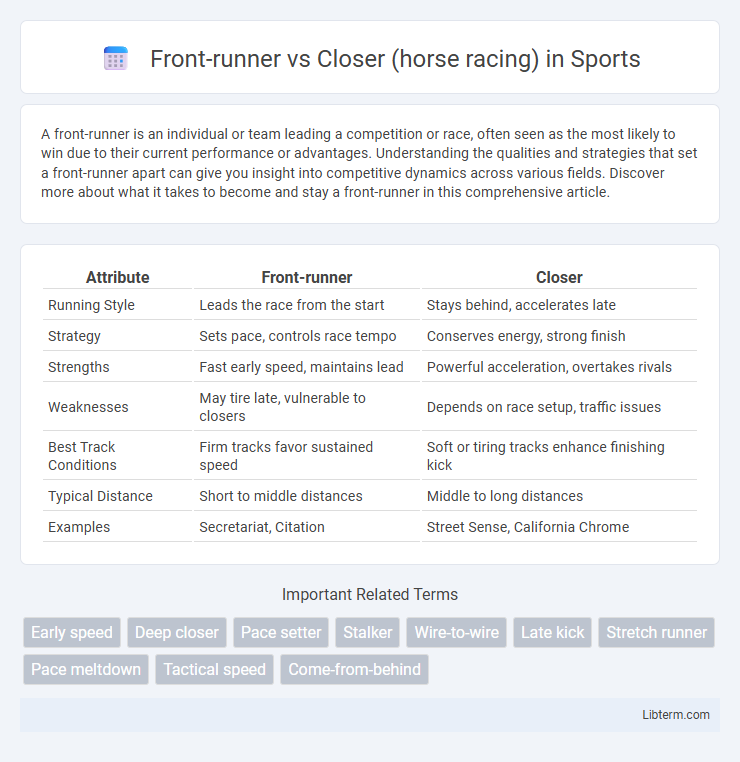A front-runner is an individual or team leading a competition or race, often seen as the most likely to win due to their current performance or advantages. Understanding the qualities and strategies that set a front-runner apart can give you insight into competitive dynamics across various fields. Discover more about what it takes to become and stay a front-runner in this comprehensive article.
Table of Comparison
| Attribute | Front-runner | Closer |
|---|---|---|
| Running Style | Leads the race from the start | Stays behind, accelerates late |
| Strategy | Sets pace, controls race tempo | Conserves energy, strong finish |
| Strengths | Fast early speed, maintains lead | Powerful acceleration, overtakes rivals |
| Weaknesses | May tire late, vulnerable to closers | Depends on race setup, traffic issues |
| Best Track Conditions | Firm tracks favor sustained speed | Soft or tiring tracks enhance finishing kick |
| Typical Distance | Short to middle distances | Middle to long distances |
| Examples | Secretariat, Citation | Street Sense, California Chrome |
Understanding Front-Runners and Closers in Horse Racing
Front-runners in horse racing excel by taking an early lead and setting the pace, relying on strong speed and stamina to maintain dominance throughout the race. Closers, on the other hand, conserve energy in the early stages and unleash a powerful finishing kick in the final stretch, capitalizing on fatigue among front-runners. Recognizing these running styles helps bettors and trainers develop strategies based on track conditions, race distance, and competition dynamics.
Key Characteristics of Front-Running Horses
Front-running horses exhibit early speed and a strong ability to take the lead immediately after the start, often setting a fast pace to control the race tempo. Their stamina and tactical positioning enable them to maintain the front position, forcing competitors to chase and expend energy. Key traits include quick acceleration, high cruising speed, and resilience in sustaining the lead during both sprint and route races.
Traits That Define a Closer in Racing
Closers in horse racing possess exceptional stamina and a powerful finishing kick, enabling them to surge forward in the final stretch after trailing the pack. These horses demonstrate patience and strategic positioning, often conserving energy by maintaining a steady pace before executing a decisive late burst. Their racing style thrives on strong acceleration and resilience, making them formidable competitors in fast-paced or long-distance races where endurance is critical.
The Impact of Race Pace on Front-Runners and Closers
Race pace critically influences the success of front-runners and closers in horse racing; front-runners benefit from a fast early pace that can tire out competitors, allowing them to maintain the lead. Closers leverage a slower early pace to conserve energy and accelerate in the final stretch, overtaking fatigued front-runners. Understanding these dynamics helps bettors predict outcomes by analyzing pace scenarios and individual horse stamina profiles.
Strategy: Advantages of Front-Runners
Front-runners in horse racing control the pace from the start, allowing them to avoid traffic and potential interference. This strategy capitalizes on setting comfortable fractions, conserving energy for the stretch run. Their advantage lies in dictating race tempo, which can unsettle competitors reliant on closing speed.
Strategy: Strengths of Closers
Closers excel in horse racing by conserving energy during the early stages, allowing for a powerful and sustained acceleration in the final stretch. Their strength lies in timing the move to overtake tiring front-runners, often capitalizing on race pace set by others. This strategy requires exceptional stamina and a strong finishing kick, making closers formidable in long-distance or pace-heavy races.
Race Conditions That Favor Front-Runners
Race conditions favoring front-runners include fast, firm tracks that allow horses to maintain high early speeds without tiring. Shorter race distances and races with a highly competitive pace often benefit front-runners by enabling them to set the tempo and control positioning. Additionally, large fields with multiple closers can create traffic and slower early fractions, giving front-runners an advantage to build an unchallenged lead.
Race Scenarios Where Closers Excel
Closers excel in race scenarios where the pace is fast and front-runners tire, allowing them to capitalize with strong late surges in the homestretch. These horses thrive on long stretches and strategically settle behind the leaders, conserving energy before unleashing powerful closing bursts. Tracks with wide lanes and extended final furlongs particularly favor closers, as they have ample space and distance to maneuver past fatigued front-runners.
Famous Front-Runners and Legendary Closers
Famous front-runners in horse racing such as Secretariat and Winning Colors are renowned for their ability to set a fast pace from the start, maintaining a strong lead throughout the race. Legendary closers like Zenyatta and John Henry are celebrated for their strategic late surges, overcoming early deficits with powerful finishing sprints to secure dramatic victories. The contrasting racing styles of front-runners and closers highlight different tactical approaches, emphasizing early speed versus endurance and timing in the final stretch.
Betting Tips: Choosing Between a Front-Runner and a Closer
When betting on horse racing, understanding the running styles of front-runners and closers is crucial for making informed wagers. Front-runners, who take the lead early and set the pace, often perform well on fast tracks and in races lacking strong early speed, making them ideal picks in such conditions. Closers, known for their strong finishes from behind, excel in races with a fast early pace that tires the leaders, so betting on a closer is advantageous when the front-runners are expected to expend too much energy early on.
Front-runner Infographic

 libterm.com
libterm.com